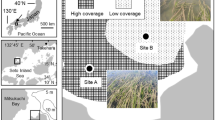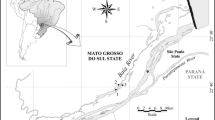Abstract
We studied the relation between aquatic vegetation coverage, summer dissolved oxygen and density of sunfishes (Lepomis spp.) in 10 shallow bays of a eutrophic reservoir. The bays ranged 5.2–15.7 ha in area, 0.6–1.3 m mean depth and 6–91% vegetation area coverage. Over the 10 bays mean dissolved oxygen concentration ranged 5.8–9.0 mg l-1 in open water at least 20 m away from the vegetation, 0.8–8.1 mg l-1 at the vegetation-water edge and 0.5–7.7 mg l-1 in dense vegetation. Dissolved oxygen concentrations were inversely related to vegetation coverage. In open water, dissolved oxygen levels were consistently higher than 8 mg l-1 when vegetation coverage was <20% of the bay and decreased to about 6 mg l-1 at coverages near 80%. At the vegetation-water edge and within dense vegetation, dissolved oxygen levels dropped rapidly as vegetation coverage increased to 20% of the bay; when vegetation reached about 50% coverage, dissolved oxygen remained near 1.5 mg l-1at the vegetation-water edge, but oxygen dropped below 1 mg l-1in dense vegetation. Scarce vegetation harbored high Lepomis relative abundance (fish per m2 of vegetation) whereas extensive vegetation harbored low relative abundance, both contributing little to absolute abundance (total fish in all vegetation); however, intermediate coverage offered a combination of mid-level fish relative abundance that together with mid-level plant coverage translated into high absolute fish abundance. We suggest this response is related to hypoxia, and where aquatic vegetation is extensive, the effect of vegetation on hypoxia and water quality in general may influence fish populations in a way similar to that often attributed to reduced foraging efficiency and increased competitive interactions.
Similar content being viewed by others
References
Anderson, O., 1984. Optimal foraging by largemouth bass in structured environments. Ecology 65: 851–861.
Baltz, D.M., C. Rakocinski & J.W. Fleeger, 1993. Microhabitat use by marsh-edge fishes in a Louisiana estuary. Envir. Biol. Fishes 36: 109–126.
Colle, D. E. & J. V. Shireman, 1980. Coefficients of condition for largemouth bass, bluegill and redear sunfish in hydrilla-infested lakes. Trans. am. Fish. Soc. 109: 521–531.
Crowder, L. B. & W. E. Cooper, 1982. Habitat structural complexity and the interaction between bluegills and their prey. Ecology 63: 1802–1813.
Dahlberg, M. L., D. L. Shumway & P. Doudoroff, 1968. Influence of dissolved oxygen and carbon dioxide on swimming performance of largemouth bass and coho salmon. J. Fish Res. Bd Can. 25: 49–70.
Dibble, E. D., K. J. Killgore & S. L. Harrel, 1996. Assessment of fish-plant interactions. In Miranda, L. E. & D. R. DeVries (eds), Multidimensional Approaches to Reservoir Fisheries Management. Am. Fish. Soc., Bethesda, Maryland: 357–372.
Diehl, S., 1988. Foraging efficiency of three fresh-water fishes: effects of structural complexity and light. Oikos 53: 207–214.
Dionne, M. & C. L. Folt, 1991. An experimental analysis of macrophyte growth forms as fish foraging habitat. Can. J. Fish. aquat. Sci. 48: 123–131.
Engel, S., 1984. Restructuring littoral zones: a different approach to an old problem. In Lake and Reservoir Management. Proceedings of the 1983 annual conference, North American Lake Management Society, Knoxville, Tennessee. U.S. Environmental Protection Agency 440/5–84–001: 463–466.
Engel, S., 1987. The impact of submerged macrophytes on largemouth bass and bluegills. Lake Reservoir Manage. 3: 227–234.
Frodge, D. J., B. T. Anderson, 1971. Predicting the diel oxygen minimum in ponds containing macrophytes. Prog. Fish-Cult. 33: 45–47.
Heck, K. L., Jr. & T. A. Thoman, 1981. Experiments on predatorprey interactions in vegetated aquatic habitats. J. exp. mar. Biol. Ecol. 53: 125–134.
Jensen, F. B., M. Nikinmaa & R. E. Weber, 1993. Environmental perturbations of oxygen transport in teleosts fishes: causes, consequences and compensations. In Rankin, J. C. & F. B. Jensen (eds), Fish Ecophysiology. Chapman & Hall, London: 463–466.
Knights, B. C., B. L. Johnson & M. B. Sandheinrich, 1995. Response of bluegill and black crappie to dissolved-oxygen, temperature and current in riverine backwater lakes during winter. N. am. J. Fish. Manage. 15: 390–399.
Lewis, Jr, W. M., 1970. Morphological adaptations of cyprinodontoids for inhabiting oxygen deficient waters. Copeia 1970: 319–326.
Lillie, R. A. & J. Budd, 1992. Habitat architecture of Myriophyllum spicatum L. as an index to habitat quality for fish and macroinvertebrates. J. Freshwat. Ecol. 4: 113–121.
Madsen, T. V. & E. Warncke, 1983. Velocities of currents around and within submerged vegetation. Arch. Hydrobiol. 97: 389–394.
Matthews, W. J., 1987. Physicochemical tolerances and selectivity of stream fishes as related to their geographic ranges and local distributions. In Matthews, W. J. & D. C. Heins (eds), Community and Evolutionary Ecology of North American Stream Fishes. University of Oklahoma Press, Norman: 111–120.
Miranda, L. E. & L. L. Pugh, 1997. Relationship between vegetation coverage and abundance, size and diet of juvenile largemouth bass during winter. N. am. J. Fish. Manage. 17: 601–610.
Miranda, L. E., K. B. Hodges & L. L. Pugh, 1996. Aquatic vegetation influences on growth and recruitment of age-0 largemouth bass in Aliceville Lake. Completion Report, Federal Aid to Sportfish Restoration Project F-040–22, Alabama Department of Conservation and Natural Resources, Montgomery: 117 pp.
Miranda, L. E., M. P. Driscoll & M. S. Allen, in press. Transient physicochemical microhabitats facilitate fish survival in inhospitable aquatic plant stands. Freshwat. Biol.
Mittelbach, G. G., 1988. Competition among refuging sunfishes and effects of fish density on littoral zone invertebrates. Ecology 61: 614–623.
Moss, D. D. & D. C. Scott, 1961. Dissolved-oxygen requirements of three species of fish. Trans. Am. Fish. Soc. 90: 377–393.
Olson, M. H., S. R. Carpenter, P. Cunningham, S. Gafny, B. R. Herwig, N. P. Nibbelink, T. Pellett, C. Storlie, A. S. Trebitz & K. A. Wilson, 1998. Managing macrophytes to improve fish growth: a multilake experiment. Fisheries 23(2): 6–12.
Perry, S. F. & G. McDonald, 1993. Gas exchange. In Evans, D. H. (ed.), The Physiology of Fishes, CRC Press, Inc., Boca Raton, Florida: 251–278.
Randall, D. J. & H. Lin, 1993. Effects of water pH on gas and ion transfer across fish gills. In Rankin, J. C. & F. B. Jensen (eds), Fish Ecophysiology. Chapman & Hall, London: 265–275.
Sand-Jensen, K., 1989. Environmental variables and their effect on photosynthesis of aquatic plant communities. Aquat. Bot. 34: 5–25.
Savino, J. F., E. A. Marschall & R. A. Stein, 1992. Bluegill growth as modified by plant density: an exploration of underlying mechanisms. Oecologia 89: 153–160.
Savino, J. F. & R. A. Stein, 1982. Predator-prey interaction between largemouth bass and bluegills as influenced by simulated, submersed vegetation. Trans. am. Fish. Soc. 11: 255–266.
Sculthorpe, C. D., 1985. The biology of aquatic vascular plants. Edward Arnold, London: 610 pp.
Smale, M. A. & C. F. Rabeni., 1995. Hypoxia and hyperthermia tolerances of headwater stream fishes. Trans. am. Fish. Soc. 124: 698–710.
Stewart, N. E., D. L. Shumway & P. Doudroff, 1967. Influence of oxygen concentration on the growth of juvenile largemouth bass. J. Fish Res. Bd Can. 24: 475–494.
Summers, G. L., 1980. Food of adult largemouth bass in a small impoundment with dense aquatic vegetation. Proc. Ann. Conf. Southeast. Assoc. Fish Wildl. Agenc. 34: 131–136.
Suthers, I. M. & J. H. Gee, 1986. Role of hypoxia in limiting diel spring and summer distribution of juvenile yellow perch (Perca flavescens) in a prairie marsh. Can. J. Fish. aquat. Sci. 43: 1562–1570.
Trebitz, A. S. & N. Nibbelink, 1996. Effect of pattern of vegetation removal on growth of bluegill: a simple model. Can. J. Fish. aquat. Sci. 53: 1844–1851.
Wegener, W. L., D. Holcomb & V. P. Williams, 1973. Sampling shallow water fish populations using the Wegener ring. Proc. Southeast. Assoc. Game Fish Comm. 27: 663–673.
Whitmore, C. M., C. E. Warren & P. Doudroff, 1960. Avoidance reactions of salmonid and centrarchid fishes to low oxygen concentrations. Trans. am. Fish. Soc. 89: 17–26.
Wiley, M. J., R. W. Gorden, S. W. Waite & T. Powless, 1984. The relationship between aquatic macrophytes and sport fish production in Illinois ponds: a simple model. N. am. J. Fish. Manage. 4: 111–119.
Wolf, N. G. & D. L. Kramer, 1987. Use of cover and the need to breathe: the effects of hypoxia on vulnerability of dwarf gouramis to predatory snakeheads. Oecologia 7: 127–132.
Author information
Authors and Affiliations
Corresponding author
Rights and permissions
About this article
Cite this article
Miranda, L.E., Hodges, K.B. Role of aquatic vegetation coverage on hypoxia and sunfish abundance in bays of a eutrophic reservoir. Hydrobiologia 427, 51–57 (2000). https://doi.org/10.1023/A:1003999929094
Issue Date:
DOI: https://doi.org/10.1023/A:1003999929094




